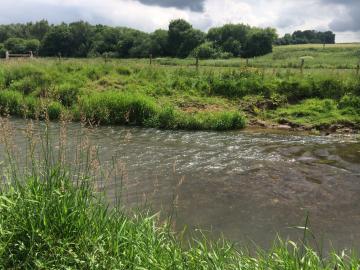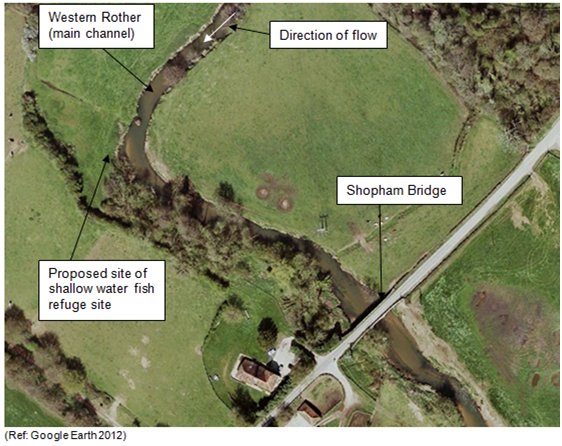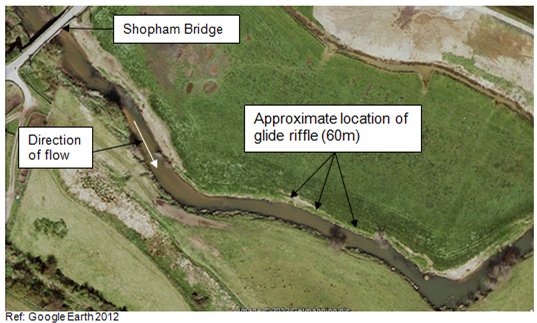
Overview
The Western Rother Fishery Habitat Enhancement Project is a partnership project that will use CRF funds to provide multiple habitat improvements on a section of the lower Rother at Shopham Bridge, just south of Petworth in West Sussex. Led by the Arun and Rother Rivers Trust (ARRT) and jointly delivered with the Wild Trout Trust (WTT), the project is supported by the Petworth and Bognor Angling Club, who will play a role in the long term maintenance of the enhancement works.
Issues to be addressed
The lower Western Rother currently provides poor quality habitat for fish. This is due to:
- Exceptionally high levels of siltation caused by modern intensive agricultural practices that increase the amount of sediment from the surrounding Greensand geology (which is naturally highly erosive) entering the river system and limiting the Rother’s ability to attain ‘Good Ecological Status’ as defined and required by the EU Water Framework Directive (WFD).
- Poor in-channel morphology due to historic river works and land management that have resulted in the river being over-wide and over-deep in places, leading to a sluggish water-flow and associated poor water quality and sedimentation issues. These factors limit riverine habitats from developing which in turn limit diverse and sustainable fish populations from establishing along the Western Rother.
- The absence of sufficient river gravels in the main Rother channel reduces the available spawning habitat for salmonids and the early life-cycle stages of many cyprinid fish species; the lack of appropriate habitat in the main river for juvenile fish and fry is recognised by the local EA and emphasises the important role that smaller tributaries currently play in helping to improve healthy and diverse fish populations on a catchment wide basis. Ensuring that these smaller tributaries have good reserves of gravel beds will enhance spawning opportunities for a wide range of flow-loving fish species and will also improve the number and diversity of macro-invertebrates, which all play a role in improving the ecological status of the Western Rother.
- The lack of appropriate ‘backwater’ habitat in the main river channel for juvenile fish and fry has recognised by various interested parties, including the local EA, for some time. During flooding events smaller fish typically have insufficient backwater habitat to be able to escape the raised flow velocities, with the risk of being washed down the river towards the estuary. Fish refuge areas to help support juvenile fish and fry are in limited supply along the Western Rother. This project will look at the potential benefits (and costs) of constructing a backwater environment in a naturally erosive Greensand area where the connectivity between the river and its surrounding land is typically poor.
The project will address these issues through targeted habitat restoration work, enhancing both fishery habitat quality and the naturalness of flow characteristics along this stretch of the Western Rother.
Description of works
The overall objectives of the project are to improve the quality of fisheries habitat in the Western Rother by managing the delivery of the following project objectives:
- Design and construction of a ~60m spawning and nursery rock and gravel glide/riffle: to raise the bed of a long, wide and deep reach of the main river channel to create a long shallow glide over a gravel bed, with the aim of the flow gradually rising to a broken riffle at the tail and providing access to clean gravel glides for spawning.
- Enhancements to two tributaries (the Burton Mill Stream, and the Sutton End Stream): gravel augmentation and habitat improvement works to improve fish populations by creating new spawning grounds. Gravel introduction will also have the associated benefit of bed-raising thus improving stream – floodplain connectivity. The enhanced gravel bed reaches will also afford a significant habitat for elvers and juvenile eels.
- Construction of an on-line fish refuge adjacent to and connected with the main channel; initial surveys have shown there is a lack of suitable habitat for juvenile fish in the main Rother channel. A suitable site for a juvenile fish refuge has been identified, upstream of Shopham Bridge,that can be used as a pilot study to help determine whether such an approach is viable on the Western Rother.
The project will also explore:
- The use of fencing to accommodate both cattle drinking areas and protected riverbank areas to help improve the habitat for both larger adult fish and also juvenile fish and fry especially at the proposed fish refuge site.
- Opportunities for re-establishing tree cover if additional funding can be obtained from other schemes. Native trees need to be planted along the Western Rother to help provide additional bank stabilisation and habitat. Once matured, the trees will also provide shade for the river and mitigate against some of the effects of predicted climate change, including low-flows, rises in water temperature and more uncertainty in occurrence peak-flow events.
Proposed fish refuge site

Proposed spawning and nursery glide

What will success look like?
The success of this project can be measured in different ways. Providing improved spawning opportunities for all flow-loving gravel spawning fish species will be deemed a direct benefit of this project; current access to clean gravel glides for spawning are extremely limited along the Western Rother. Seams of suitable gravel are present on the two tributaries identified in this project brief but they are very limited in extent and improving spawning opportunities on the bottom sections of these two tributaries will help to sustain locally healthy Rother fish populations. The large gravel riffle installed further upstream by the EA as part of the Shopham Loop project is considered by all parties to be a great success. The proposed new glide/riffle habitat on the main river will raise the bed of a long, wide and comparatively deep glide that currently lacks any opportunities for fish recruitment. A further key determinant of success we hope will be in strengthening the understanding and long term commitment of local angling clubs, the wider community and landowners to improving this stretch of the Western Rother and valuing this unique and much-loved habitat. Our primary aim is to see the Western Rother achieve Good Ecological Status under the WFD. This will mean a return to more natural flow regimes, improved water quality, increased riverine habitat, better river-land connectivity and thus a more diverse, robust and sustainable ecological system.
About the team
Project Manager: Mrs Ses Wright, ses.wright@oart.org.uk,
WTT Partner Project Manager: Andy Thomas, athomas@wildtrout.org
Environment Agency: Damon Block, damon.block@environment-agency.gov.uk
ARRT Administrator: Mrs. Tracy Thurlow, info@arrt.org.uk
ARRT Chairman: Sir Sebastian Anstruther